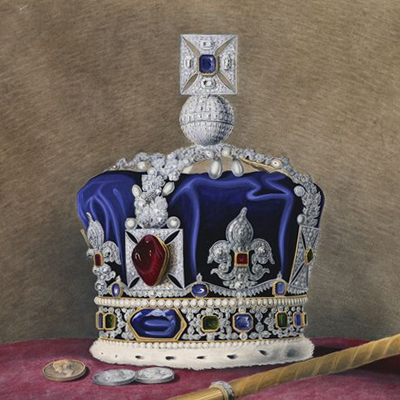
Famous Sapphire Jewellery, Part 7: The Maltese Cross of the Imperial State Crown, Home of St. Edward's Sapphire
Share
What is perhaps the most well known piece of British sapphire regalia is the Imperial State Crown. British monarchs have worn some form of the Imperial State Crown after their coronation ceremony and during the State Openings of Parliament since the 17th century, but the current version of the crown was crafted in 1937. The crown holds two supreme sapphires, the Stuart Sapphire and St. Edward’s Sapphire among a number of other famous gems, including the Cullinan II Diamond and the Black Prince's Ruby. Both of these blue gems are precious in their own right, and have each taken their own journey before arriving in the English crown where they now sit.
The story of St. Edward’s Sapphire goes back further than almost any other crown jewel. It is believed that in the time before the Norman conquest of England, the sapphire belonged to St. Edward the Confessor. Supposedly the stone was mounted in a ring that was used for his coronation ceremony when he took the throne in 1042. Legend has it that sometime during his early rule, the pious and generous king gave his ring to a beggar one day when he ran out of coins after giving money to all the other beggars he had encountered. Many years later, two Britons on pilgrimage in Syria were said to have encountered a man that claimed to be John the Evangelist, who had been in disguise as a beggar in England years earlier, and he gave the pilgrims Edward’s sapphire ring to take back to the monarch, saying that Edward would soon be allowed to see “paradise” in six months. Upon their return to England, the pilgrims delivered the ring and John’s message to Edward, who accepted the ring and began preparing for his own death. St. Edward then died six months later in 1066, and was buried in Westminster Abbey only one week after its final consecration; at this time, St. Edward's Sapphire was buried with the deceased king among a number of other ornaments.

Edward’s body was moved to various locations within the church multiple times, starting with the first reinterment in 1163; a grand tomb was built for St. Edward in 1269 by King Henry III, when Edward’s body was relocated for the last time. At some point Edward’s coffin was opened and the regalia that had been buried with the king were removed due to the significance which they held for the British monarchy; following the canonization of Edward as a saint, the regalia became holy relics and were considered to be the source of future rulers’ divine authority. The relics of St. Edward were used in the coronation ceremonies for all English kings and queens that followed, until Oliver Cromwell destroyed the regalia in 1649 at the end of the Second English Civil War; somehow, St. Edward’s sapphire survived the war and Cromwell’s efforts to disparage the monarchy.

The sapphire resurfaced in 1660 when the monarchy was reinstated by King Charles II, at which time it is thought that the gem was recut to its current size; St. Edward’s Sapphire is a stunning deep blue gem which has been given an octagon shaped rose cut. For his coronation crown, Charles II and the rulers that immediately followed him used a State Crown which was a recreation of the original St. Edward relic that was destroyed by Cromwell. This practice changed when Queen Victoria commissioned her own coronation crown from jewellers Rundell and Bridge in 1838. The new crown was the first version of what is now the contemporary Imperial State Crown; Victoria had St. Edward’s Sapphire set into the Maltese cross at its peak, and the Stuart Sapphire set into the front of the crown’s circlet.

Read more about the Stuart Sapphire in the next instalment of this series.
Here are some of our favourite sapphire jewellery pieces from the Skyjems catalog:
© Yaĝé Enigmus









